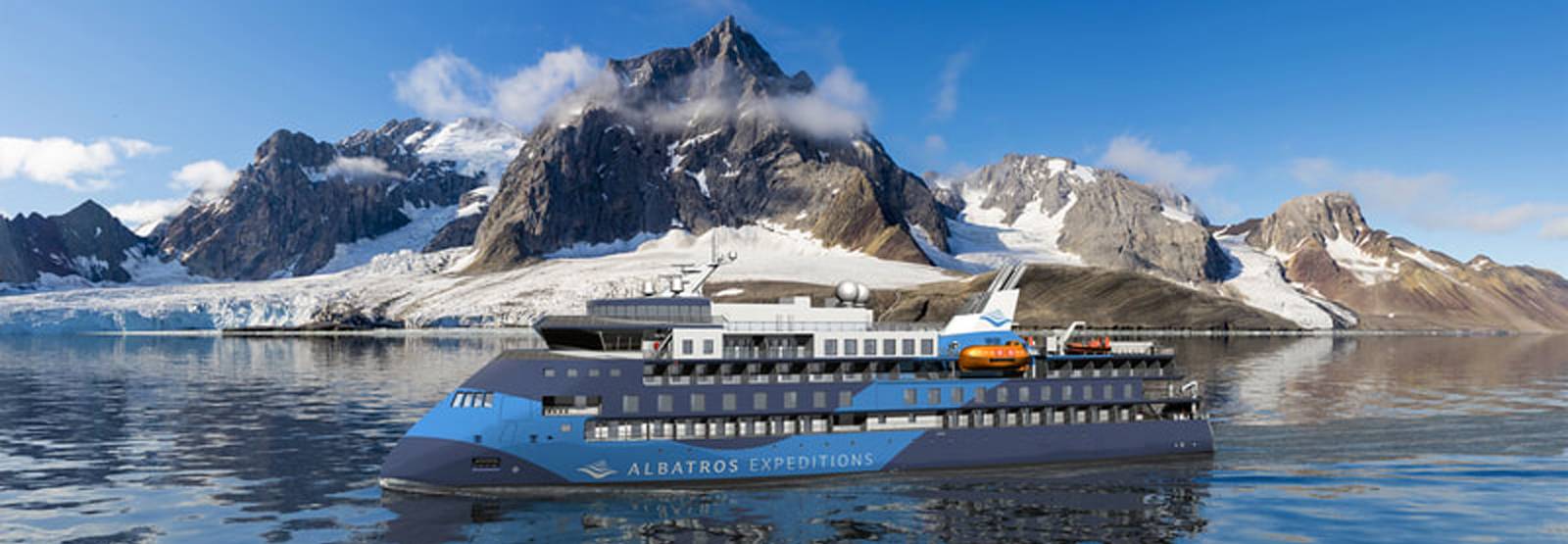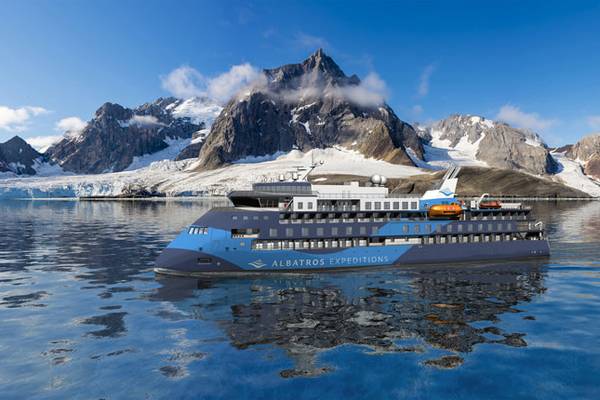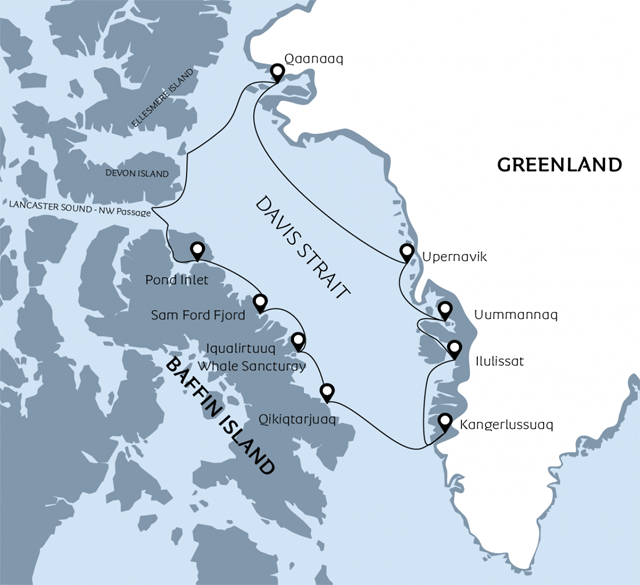HIGHLIGHTS
- Inuit
settlements of Nunavut on Baffin Island
- Bowhead
whale sanctuary at Isabella Island, Baffin
- Sam
Ford Fjord, mountains “of another world”
- Colorful
Inuit settlements along Greenland’s northwest coast
- Ilulissat,
“Iceberg Capital of the World. Many optional excursions
Optional
Excursions
- Day
12: Flightseeing over the icebergs.
- Day
12: Sailing among icebergs.
- Day
14: 4WD bus excursion to Reindeer Glacier at the edge of the Icecap.
DATES / RATES
Rates are listed per person
|
| Start Date | End Date | From EUR | From USD |
|---|
Rates are listed per person
|
| Start Date | End Date | From EUR | From USD |
|---|
ITINERARY
DAY
1: ICELAND TO KANGERLUSSUAQ FLIGHT
In
the afternoon, we board our chartered flight in Keflavik, Iceland,
bound for Kangerlussuaq in Greenland.
Upon
arrival to Kangerlussuaq (Søndre Strømfjord), we
will be transported to the small port located west of the airport,
where our ship Ocean Albatros, will be anchored. Zodiacs will transfer
us the short distance to the ship, where you will be checked in to your
stateroom. After the mandatory safety drill, you will enjoy a dinner as
Ocean Albatros ‘sets sail’ through the
160-kilometer Kangerlussuaq fjord.
DAY
2: AT SEA TOWARDS BAFFIN ISLAND, GET TO KNOW THE SHIP, ENJOY LECTURES
ON WILDLIFE AND CULTURE IN THE NUNAVUT TERRITORY
We
now have a day at sea, where the ship is heading across Davis Strait to
Baffin Island in the Canadian territory of Nunavut. During our
crossing, there are good opportunities to relax in the ship's library,
participate in the series of lectures held by Albatros
Expeditions’ lecturers and look for seabirds and whales on
our course to the southwest.
Our
onboard lecturers will make inspiring and enriching presentations about
both John Davis, Canada's and Greenland’s past history and
about the unique polar wildlife, nature and climatology.
The
west coast of Greenland is favored by mild waters of the Gulf Stream,
whereas the Baffin Island current along Baffin Island's shores is cold.
The officers on the bridge will keep an eye out for the icebergs,
flowing down "Iceberg Alley" from the big glaciers in Greenland and
Arctic Canada.
DAY
3: SETTLEMENT VISIT IN QIKIQTARJUAQ (“THE BIG
ISLAND”) ON BAFFIN
Overnight
we have approached Cape Dyer, where the United States established one
of their many DEW (Distant Early Warning) stations that surround the
Arctic continental American. Cape Dyer itself is a towering edge
towards the Davis Strait of about 800-meter elevation. The cliff and
the station could very well be our first view of Arctic Canada (if
you’re awake!).
Like
its Greenlandic named counterpart Qeqertarsuaq, Qikiqtarjuaq means
“the big island”. The town with around 600
inhabitants lies on an island outside of Baffin’s east coast.
The area is known for their many whales, and the Bowhead whale (also
known as the Greenland right whale or Arctic whale) which is only found
in polar waters, is often observed in congregations here.
DAY
4: ISABELLA BAY AND NINGINGANIQ NATIONAL WILDLIFE AREA
We
follow the Baffin Island east coast further north to Isabella Bay,
which is designated a Bowhead whale sanctuary, so if we
haven’t had any sightings yet, the chances are very good with
hundreds of whales feeding here each summer. The Ninginganiq marine
habitat around Isabella Bay is since 2010 a protected National Wildlife
Area. This is an important habitat for a lot of marine mammals and
seabirds, apart from the Bowhead whales. The Inuktitut word
"Ninginganiq" translates roughly into "the place where fog sits". We
hope to avoid this foreboding name as we journey into the bay and keep
a watchful eye for the excitingly abundant fauna.
Eastern
Arctic Canada is the territory of Nunavut. The North Eastern area that
includes Ellesmere, Devon and Baffin Island is known as the Qikiqtaaluk
region. It covers an area of nearly 1 million square kilometers, which
is roughly half of Greenland. The desolate landscapes offer us
beautiful views that can stretch for hundreds of kilometers over the
glacially scarred landmasses.
DAY
5: SAM FORD FJORD, MAJESTIC MOUNTAINS RAISING STRAIGHT OUT OF THE SEA
The
sheer magnitude of vertical rocks on each side of the Sam Ford Fjord,
make it worth a side step. For many rock climbers these steep granite
walls are pilgrimage objects. However, we are not adventuring in here
for climbing, but much more for the natural beauty of the fjord and the
dark waters that are home to narwhals and seals. The isolated fjord was
created by glaciers and some of the cliffs rises to 1500 meters above
sea level. In this amazing wilderness area, we also hope to spot many
migratory birds.
DAY
6: MITTIMATALIK (POND INLET), THE INUIT SETTLEMENT KNOWN AS ONE OF
“THE JEWELS OF THE NORTH”
Pond
Inlet, which in the local Inuit language is named Mittimatalik is a
town of 1600 inhabitants, of which most are Inuit. We take a stroll
through the town and we will do well to notice the building styles and
culture, as we will compare these to what we see later in Greenland.
The
polar Arctic climate allows for only short summers. Still visitors like
us come here to experience the spectacular views with mountains,
glaciers and icebergs floating along.
After
our visit we head back to our ship for lunch and head north through the
Eclipse Sound dividing Baffin Island and Bylot Island.
DAY
7: CRUISING INTO LANCASTER SOUND, START OF NORTHWEST PASSAGE
Today
we cruise further north into the gateway to the Northwest Passage,
Lancaster Sound. Depending on the ice situation and the weather, we
will make our way into the entrance of the passage. The idea of a short
cut through the North West to the Pacific Ocean was alive for hundreds
of years before it was finally deemed too difficult. A few icebreaking
tanker ships from Canadas northern oil fields are the only commercial
ships navigating the route.
During
the day we will cruise along the eastern coast of Devon, which is the
largest uninhabited island in the world. We will continue north towards
Ellesmere Island, which is the third largest island in Arctic Canada.
All migrations of the Inuit to Greenland have crossed over Ellesmere
Island and Smith Sound. Our course will break east and set straight for
Greenland’s western coast, as we wave our goodbyes to the
Canadian coasts and waters.
Smith
Sound and its northern continuation, the Kennedy Channel have strong
currents, acting as an outlet for polar pack ice and icebergs from the
Arctic Ocean. Our bridge officers will of course keep a vigilant watch
as we approach Greenland.
DAY
8: QAANAAQ, NORTHERNMOST TOWN IN GREENLAND
During
the night we will have traversed Smith Sound and we arrive at
Greenland’s northwest corner. Entering Inglefield Bay, we
pass some of Greenland’s biggest bird cliffs and are again in
habituated areas. The Captain anchors Ocean Albatros off Qaanaaq, the
only proper town in northwest Greenland.
The
town was founded in 1953, when the Americans built their base near the
original trading post of Thule. All Inuit were transferred to this new
place. Today, some 600 people live in Qaanaaq, which is supported
weekly by Air Greenland flights and twice a year by cargo ship.
We
take a walk through the town, where we can visit the small museum, and
the well stoked super market.
DAYS
9: AT SEA THROUGH THE MELVILLE BAY
Having
left Qaanaaq in the evening, we pass the American Thule Base as well as
Meteor Island and settlement of Savissivik during the night. The
Melville Bay is an exciting and adventurous place to travel through.
Until modern times, yearlong sea ice and plenty of calving glaciers
into the bay isolated North Greenland, and it was only through the
adventurous dogsledding expeditions and tireless work of Knud Rasmussen
and his friends at the beginning of nineteen hundred that the Thule
Inuit came into contact with the Greenlanders further south. The
language of the Northern Inuit is still different from the rest of
Greenland.
DAY
10: UPERNAVIK TOWN AND THE WORLD’S NORTHERNMOST OPEN AIR
MUSEUM
The
Upernavik territory covers an area nearly the size of Great Britain. In
the town itself and the ten smaller settlements in the area, inhabits
3000 people, mostly Inuit hunters. Upernavik is home to the
world’s northernmost open air museum with well-preserved
buildings from the colonial period. Today, Upernavik is a mix between
the hunter culture of old and the new wave with high-tech fishing. You
can equate the old and new with the dog sleighs that exist alongside
the modern snowmobiles. Even this far north the modern times are
catching up.
The
city itself was founded as a Danish colonial station, but the
surrounding areas and small villages history go back more than 4500
years. This was when groups of hunters and gatherers travelled along
the coasts of Alaska, Canada and ultimately Greenland.
We
anchor and make a landing, allowing us to visit the little city and the
museum.
Leaving
Upernavik behind us we pass Svartenhuks darkly colored hills, we keep a
lookout for the whales these waters are famous for.
DAY
11: UUMMANNAQ AND A STROLL THROUGH GREENLAND'S MOST BEAUTIFULLY LOCATED
TOWN
When
you wake up this morning, you will find yourself almost 600km north of
the Arctic Circle, and in one of Greenland’s most beautiful
and sunny regions. The ship has reached Uummannaq, situated on a small
island. The impressive 1,175m heart-shaped mountain has given the town
its name dominates the view (Uummannaq means ‘place where the
heart is’). There will be time to explore the city before
heading back to the ship for lunch.
DAY
12: ILULISSAT, THE CAPITAL OF THE ICEBERGS
Ilulissat
is one of the most scenic located towns in Greenland. The name simply
means ‘icebergs’ in Greenlandic, and the
town’s nickname is rightly ‘the Iceberg Capital of
the World’.
Just
south of town, Ilulissat Icefjord expels gigantic icebergs into the
cold waters of Disko Bay. These impressive frozen structures are born
some 30km deeper into the fjord by the enormous Sermeq Kujalleq
Glacier. This 10km wide glacier is the most productive outside of
Antarctica. Whereas most glaciers only calve at a rate of approximately
a meter/three feet a day, the Ilulissat glacier moves forward at a rate
of 25 meter per day, producing more than 10% of all icebergs in
Greenland. These facts, together with the fjord’s
unforgettable scenery, have secured the Ice fjord a place on
UNESCO’s World Heritage List.
During
the more than 250 years that have passed since the establishment of
Ilulissat, the town has steadily flourished. Today, Ilulissat is
Greenland’s third largest town, with more than 4,500
inhabitants. The town is very vibrant, welcoming and lively with a wide
range of cultural attractions, according to Greenlandic standards. The
legendary Arctic explorer, Knud Rasmussen was born in Ilulissat.
During
the visit you will have the opportunity to join a boat trip to the Ice
fjord (optional excursion). The journey takes about two and a half
hours in total, a great opportunity to take a closer look at the
amazing ice-sculpted scenery.
If
a hike or a trip by boat does not present enough excitement, there is
also an opportunity to arrange a flight excursion in fixed wing
aircrafts over the Ice fjord (optional excursion).
Please
note the boat and flight excursions to the Ice fjord are not included
in the general tour price. Refer to Price Information for more details.
In
the evening, we will cruise southward, leaving lovely Disko Bay behind
us as we part.
DAY
13: AT SEA, LECTURES AND BIRD WATCHING
The
last day will be at sea getting glimpses of sea birds migrating south.
Our
lecturers onboard will make inspiring and enriching presentations about
Greenland’s history, nature, wildlife and climatology. Enjoy
the captain’s farewell drink and a slideshow with all the
memories and highlights from our voyage made by the onboard
Photographer this evening.
DAY
14: KANGERLUSSUAQ. FLIGHT TO ICELAND
During
the night, we will have completed our passage through the
160-kilometer/100 mile Kangerlussuaq Fjord. After breakfast aboard the
ship, we will bid farewell to the ship's staff and the Zodiac boats
will shuttle us to shore.
Due
to Kangerlussuaq’s military history and present-day role as
an important air travel hub, Kangerlussuaq remains fairly isolated from
Greenland’s rich cultural traditions, in comparison to other
regions. While you still find cultural experiences when visiting
Kangerlussuaq, the most impressive attraction is the surrounding
nature, which is just beckoning to be explored.
In
Kangerlussuaq, we offer an optional excursion (not included in the tour
price) to the beautiful Reindeer Glacier. The duration of the excursion
is about four hours. We do not recommend the excursion for people who
suffer from bad necks or backs, as the gravel road to the ice sheet is
occasionally bumpy and uneven.
Your
arctic adventure and time in Greenland concludes as we board the flight
from Kangerlussuaq to Keflavik Airport, Iceland.
 (Click image to view Ship details)
(Click image to view Ship details)
WHAT'S INCLUDED
- Charter
flight Reykjavik-Kangerlussuaq-Reykjavik
- Transfer
to/from Kangerlussuaq Port
- English-speaking
expedition team
- Nature
hikes and Zodiac cruises per itinerary
- Near-port
town and settlement walks with expedition team
- Information
briefings and lectures by expedition team
- Full
board on ship
- Free
coffee, tea and afternoon snacks on the ship
- Welcome
and farewell cocktails
- Taxes,
tariffs and AECO fees
- Special
photo workshop
- Welcome
and farewell cocktails
- Digital
visual journal link after voyage, including voyage log, gallery,
species list and more!
EXCLUSIONS
- Hotel
accommodations pre and post cruise
- Travel
insurance
- Cancellation
insurance
- Extra
excursions and activities not mentioned in the itinerary
- Single
room supplement
- Meals
not on board the ship.
- Beverages
(other than coffee and tea).
- Tips
for the crew (we recommend USD 14 per person per day).
- Personal
expenses.
- Anything
not mentioned under 'Price includes'.
ADVENTURE
OPTIONS
- Zodiac
Cruises
- Kayaking
- USD 250
- Lectures
- Photography
- Tundra
- Wildlife
Observations
- Hiking
- Greenland
Ice Cap







